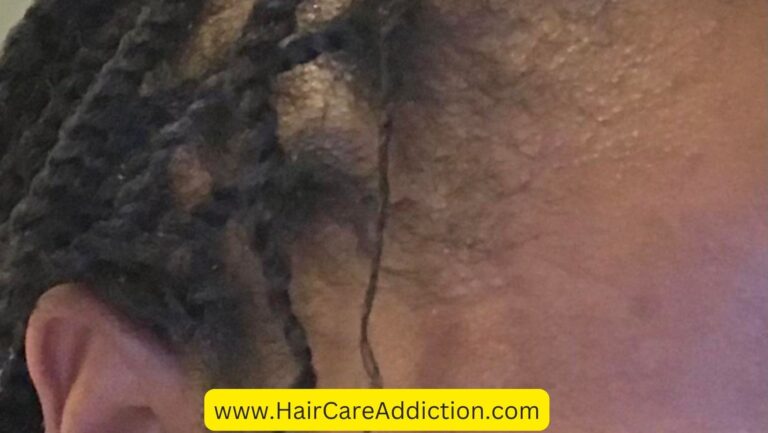Why Do Sisterlocks Itch: Causes, Prevention, and Treatment

Itching and discomfort are common issues people face after getting Sisterlocks installed, especially during the first few weeks.
Don’t worry – there are ways to alleviate the itchiness and make your transition more comfortable.
In this article, we’ll discuss the reasons behind Sisterlocks itch and provide solutions to help you fix the problem.
Why Do Sisterlocks Itch?

There could be several reasons why your Sisterlocks are causing itchiness:
- Dryness and dehydration: A lack of moisture can make your scalp dry and itchy. Keep your scalp hydrated by using oils or moisturizing sprays.
- Fungal infection or mildew: If your Sisterlocks aren’t kept clean or properly dried, fungal infections or mildew can develop, causing itching, flaking, and a foul odor.
- Product buildup: Over time, hair products and dead skin cells can accumulate on your scalp. If your locks aren’t properly cleansed, this buildup can lead to itching and discomfort.
- Faulty technique: Tight braids can cause tension and pull hair follicles, leading to itchiness. Make sure your locks aren’t too tight during the installation process.
- Dandruff: This common scalp condition causes flaking and itching. Manage it through proper cleansing and using an anti-dandruff shampoo.
- Understimulation: If your scalp isn’t properly stimulated, it can become itchy and uncomfortable. Scalp massages and regular brushing can help increase blood flow and reduce itching.
How to Stop and Prevent Sisterlocks Itch
To stop and prevent Sisterlocks itch, follow these tips:
- Maintain a clean scalp by washing your locks regularly with a gentle shampoo.
- Keep your scalp moisturized using natural oils like coconut oil, jojoba oil, or tea tree oil.
- Ensure your Sisterlocks are properly dried after washing to avoid fungal infections or mildew.
- Avoid using heavy, greasy products that can cause product buildup.
- Use an anti-dandruff shampoo if needed.
- Give yourself regular scalp massages to stimulate blood flow and prevent understimulation.
- Make sure your Sisterlocks are not installed too tightly.
Best Oils for Itchy Sisterlocks
Some of the best oils for alleviating itchiness in Sisterlocks include:
- Coconut oil: A natural moisturizer with antifungal properties.
- Jojoba oil: Closely resembles the natural sebum produced by your scalp, making it an excellent moisturizer.
- Tea tree oil: Has antifungal and antibacterial properties that can help with dandruff and itchiness.
- Lavender oil: Offers a soothing effect on the scalp and reduces inflammation.
Always dilute essential oils with a carrier oil before applying them to your scalp to avoid irritation.
How to care sisterlocks?
First and foremost, keeping your Sisterlocks clean is crucial to their overall health and appearance.
It’s important to use a sulfate-free shampoo diluted with water to gently cleanse your locks without stripping them of their natural oils.
This ensures that your Sisterlocks remain moisturized and free from product buildup, allowing them to thrive and maintain their luster.
After washing your Sisterlocks, it’s essential to keep them moisturized with a high-quality leave-in conditioner.
This product helps to lock in moisture and prevent dryness, promoting healthy and shiny locks. Remember, hydrated Sisterlocks are happy Sisterlocks!
Sleep in Satin or Silk Sleeping with a satin or silk pillowcase is a must for maintaining your Sisterlocks.
These materials help to reduce friction and breakage while you sleep, ensuring your locks remain smooth and intact.
Additionally, avoid using heavy oils and products that can weigh down your Sisterlocks and cause buildup. Instead, opt for lightweight, natural options to keep your locks healthy and manageable.
Keep Your Sisterlocks in Check Every 4-6 weeks, it’s important to use a clarifying shampoo to remove any residual product buildup and maintain the cleanliness of your Sisterlocks.
Additionally, regular visits to your Sisterlocks consultant for retightening and maintenance will keep your locks looking fresh and well-groomed.
One of the many perks of Sisterlocks is the ability to experiment with various styles and hair accessories.
While trying new looks is exciting, it’s essential to be gentle when styling and detangling your locks to prevent breakage.
Treat your Sisterlocks with care, and they’ll continue to look stunning and stylish.
To keep your Sisterlocks in their best condition, it’s important to protect them from damage and breakage.
Wearing a satin or silk scarf or bonnet at night is a simple yet effective way to keep your locks safe while you sleep.
Additionally, avoid using heat styling tools and tight hairstyles that can cause tension and damage your Sisterlocks.
Opt for gentle, heat-free styling methods to preserve the integrity of your locks.
Other problem with sisterlock
While sisterslock are a fantastic choice for many, like any hairstyle, they come with potential challenges that should be considered. Here are some problems that can be associated with Sisterlocks:
Installation time: The creation of Sisterlocks is a meticulous and time-consuming process. Depending on hair length and thickness, the installation can take anywhere from 15 to 20 hours, or sometimes even more, spread over multiple sessions. This can be quite inconvenient and exhausting for some people.
High initial cost: Sisterlocks need to be installed by a certified Sisterlocks consultant, which can be a significant investment. The cost can vary greatly depending on the length and thickness of the hair, but it’s generally more expensive than traditional locks. Also, the maintenance cost over time adds up, including retightenings and consultations.
Lock slippage: Slippage, or the unravelling of the locks, can be a significant issue, especially in the early stages before the Sisterlocks fully settle. This can be caused by a variety of factors like improper maintenance, excessively oily hair, or even certain hair products. In severe cases, the slipped locks may need to be reinstalled.
Limited number of certified professionals: Finding a certified Sisterlocks consultant or trained loctician can be difficult, depending on your location. The requirement for a certified professional not only affects the initial installation but also the ongoing maintenance. This limited availability can lead to scheduling difficulties and higher costs.
Increased maintenance: While Sisterlocks are generally considered a low-maintenance hairstyle, the first few months require careful attention to ensure they form correctly. This includes avoiding certain hair products and washing methods. Regular appointments for retightening are also necessary, which may be considered time-consuming.
Potential for damage: If Sisterlocks are not properly installed and maintained, they can potentially lead to hair damage. Excessive tension can cause traction alopecia, a form of hair loss. It’s crucial to find a skilled professional who understands the correct installation technique to prevent such issues.
Permanence and removal: Sisterlocks are semi-permanent, which means removing them can be a lengthy and delicate process that often results in some amount of hair loss. Those who wish to transition out of Sisterlocks may need to trim or shave their hair, which some might find undesirable.
Styling limitations: In the initial settling period (around six months or more), styling options can be limited to prevent slippage. After settling, while there are numerous ways to style Sisterlocks, extremely tight or tension-heavy hairstyles should be avoided to prevent hair damage.
Itchiness is a common issue after installing Sisterlocks, but with proper care and attention, you can manage and prevent it.
Identify the cause of your itchiness and take appropriate steps to alleviate the discomfort.
Remember, a healthy scalp is essential for maintaining beautiful and comfortable Sisterlocks.






